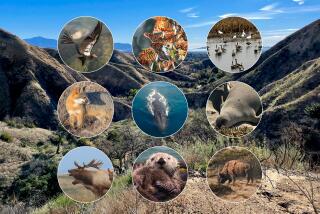Tufted puffin
- Share via
[FRATERCULA CIRRHATA]
Rocky islands along the California coast host a tremendous variety of nesting seabirds each June, but none is as flamboyant as the tufted puffin. Looking around with bemused expressions, puffins seem oblivious to the fact that everyone is staring at their wild hairdos. The clownish look is further accentuated when parents fly to nest sites with mouthfuls of small fish hanging down each side of their faces. In the early morning, adults can often be seen in front of their nesting burrows near the tops of steep, rocky cliffs. The solitary chick grows up in a burrow or rock crevice, safe from predators, until it is ready one night to flutter or walk down the slope for its maiden voyage. By winter, puffins have moved far offshore and are seldom seen from land.
NATURAL HISTORY
In the early 1900s, these harlequin-faced ducks nested by the thousands as far south as the Channel Islands, but oil spills and the collapse of sardine populations because of overfishing have left only 250 puffins in California. Today, the Farallon Islands off San Francisco and the Castle Rock National Wildlife Refuge near Crescent City are the best spots to see these birds.
KEY CHARACTERISTICS
The size of a pigeon but more than twice as heavy, black except for its orange-red feet and outrageously large bill and a pure white face.
More to Read
Sign up for The Wild
We’ll help you find the best places to hike, bike and run, as well as the perfect silent spots for meditation and yoga.
You may occasionally receive promotional content from the Los Angeles Times.






